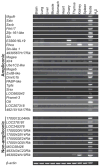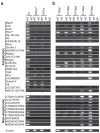The mouse X chromosome is enriched for multicopy testis genes showing postmeiotic expression
- PMID: 18454149
- PMCID: PMC2740655
- DOI: 10.1038/ng.126
The mouse X chromosome is enriched for multicopy testis genes showing postmeiotic expression
Abstract
According to the prevailing view, mammalian X chromosomes are enriched in spermatogenesis genes expressed before meiosis and deficient in spermatogenesis genes expressed after meiosis. The paucity of postmeiotic genes on the X chromosome has been interpreted as a consequence of meiotic sex chromosome inactivation (MSCI)--the complete silencing of genes on the XY bivalent at meiotic prophase. Recent studies have concluded that MSCI-initiated silencing persists beyond meiosis and that most genes on the X chromosome remain repressed in round spermatids. Here, we report that 33 multicopy gene families, representing approximately 273 mouse X-linked genes, are expressed in the testis and that this expression is predominantly in postmeiotic cells. RNA FISH and microarray analysis show that the maintenance of X chromosome postmeiotic repression is incomplete. Furthermore, X-linked multicopy genes exhibit a similar degree of expression as autosomal genes. Thus, not only is the mouse X chromosome enriched for spermatogenesis genes functioning before meiosis, but in addition, approximately 18% of mouse X-linked genes are expressed in postmeiotic cells.
Figures





Comment in
-
The not-so-silent X.Nat Genet. 2008 Jun;40(6):689-90. doi: 10.1038/ng0608-689. Nat Genet. 2008. PMID: 18509310 No abstract available.
References
-
- Wang PJ, McCarrey JR, Yang F, Page DC. An abundance of X-linked genes expressed in spermatogonia. Nat Genet. 2001;27:422–6. - PubMed
-
- Khil PP, Smirnova NA, Romanienko PJ, Camerini-Otero RD. The mouse X chromosome is enriched for sex-biased genes not subject to selection by meiotic sex chromosome inactivation. Nat Genet. 2004;36:642–6. - PubMed
-
- Reinke V. Sex and the genome. Nat Genet. 2004;36:548–9. - PubMed
-
- McKee BD, Handel MA. Sex chromosomes, recombination, and chromatin conformation. Chromosoma. 1993;102:71–80. - PubMed
-
- Turner JM. Meiotic sex chromosome inactivation. Development. 2007;134:1823–31. - PubMed
Publication types
MeSH terms
Substances
Grants and funding
LinkOut - more resources
Full Text Sources
Other Literature Sources
Molecular Biology Databases

